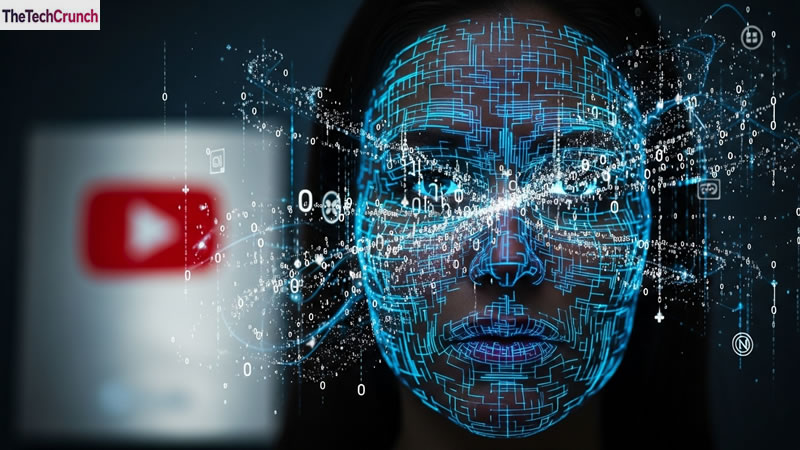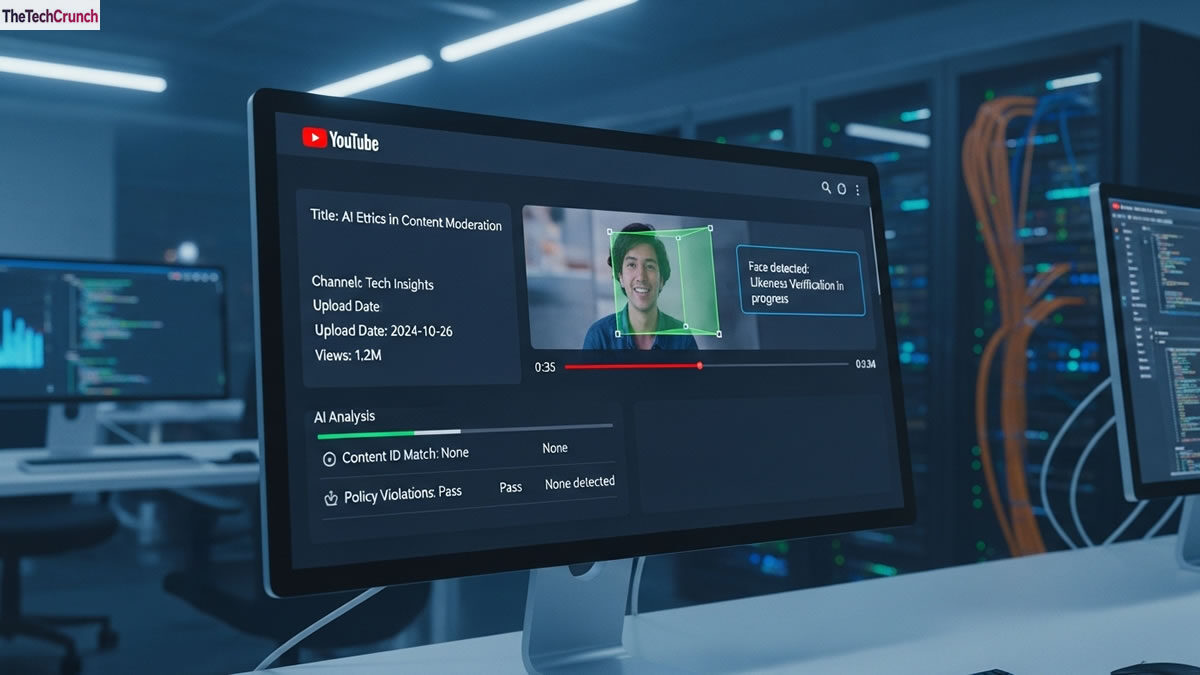YouTube has officially launched its likeness-detection technology, marking a major step toward protecting people’s digital identities. The platform is taking this action in response to growing concerns over deepfakes and unauthorized AI-generated videos. With the rise of artificial intelligence tools, it has become easier to create videos that mimic real faces, voices, and gestures.
Stay up to date with the latest technology in TheTechCrunch. This covers artificial intelligence, mobile and web apps, modern things, cybersecurity, and general technical news. From AI’s successes to chat and generative tools. Such as smartphones, laptops, and wearables’ special reviews. TheTechCrunch gives an insight into this case.
YouTube’s new feature aims to detect such content and give people more control over how their likeness is used online. The technology uses advanced AI models to identify when someone’s image or voice has been replicated without permission. Once detected, YouTube can alert affected users and take appropriate action to remove or flag the content. This launch represents YouTube’s commitment to maintaining safety and authenticity on its platform.
The Growing Problem of Deepfakes
Over the last few years, deepfake technology has exploded in popularity. AI can now create realistic-looking videos where people appear to say or do things they never actually did. While some uses are harmless, like entertainment or satire, others are far more dangerous. Deepfakes have been used in misinformation campaigns, scams, and even identity theft.
Social media platforms, including YouTube, have struggled to control this kind of content. Many users are unable to tell the difference between real and fake videos. This creates confusion, damages reputations, and can cause emotional distress. YouTube’s new likeness-detection system is a direct response to these growing risks.
How The Technology Works
YouTube’s likeness-detection technology uses machine learning and facial recognition algorithms to analyze uploaded videos. It scans for patterns in faces, voices, and gestures that match a real person’s identity. When a match is found, the system compares it to existing public data to determine whether the likeness is genuine or artificially generated.

If the technology detects manipulation, it flags the video for review. YouTube then assesses whether the video violates its policies. If the person’s likeness was used without consent, the platform can remove the content or restrict its visibility. Affected individuals can also file a formal request for removal under YouTube’s updated identity policy.
The company says this system has been carefully tested to minimize false positives. It focuses on clear cases of impersonation, ensuring that legitimate uses like parody, art, or commentary are not wrongly removed.
A Step Toward Responsible AI Use
The launch of likeness-detection technology shows that YouTube is taking AI responsibility seriously. As AI-generated content becomes more common, platforms must find ways to protect users while still supporting creativity. YouTube’s approach balances both priorities.
The company acknowledges that AI offers new creative opportunities. Many creators use generative tools for editing, animation, or storytelling. However, YouTube also understands the risks that come with misuse. The likeness-detection feature aims to prevent harm while allowing innovation to continue.
This aligns with YouTube’s broader strategy for ethical AI. The platform has previously introduced tools to identify synthetic media and requires disclosure when AI-generated visuals are used in videos.
Empowering Users With Control
One of the key goals of this feature is to empower users. People now have more control over how their likeness appears on YouTube. If someone finds a video that misuses their face or voice, they can report it more easily. The new system helps validate such claims using automated detection and human review.
YouTube’s identity protection team will handle reports and take appropriate action. This could include removing videos, issuing warnings, or restricting monetization for repeat offenders. The process is designed to be fast and transparent, reducing the frustration that often comes with content reporting.
This also helps protect public figures, influencers, and creators whose images are frequently used in fake videos. By providing tools for self-defense, YouTube hopes to build a safer environment for everyone.
Collaboration With Industry Experts
YouTube developed the likeness-detection system in collaboration with leading AI researchers and digital ethics organizations. The goal was to create technology that balances detection accuracy with respect for privacy.
Experts from Google’s DeepMind and other AI ethics labs contributed to refining the algorithms. They ensured that the system does not store personal data unnecessarily and that user privacy is protected throughout the detection process.
YouTube’s partnership with these experts reflects the company’s focus on responsible innovation. It wants to ensure that the fight against deepfakes does not come at the cost of user rights.
Impact On Content Creators
For YouTube creators, the new feature means a shift in how content is managed. Creators who use AI-generated elements must now be transparent about it. If a video includes synthetic likenesses of real people, it needs to be labeled clearly.

Failure to do so may result in policy violations or demonetization. However, YouTube has made clear that the goal is not punishment but education. The platform wants creators to understand the ethical and legal implications of using AI likenesses.
This move could also encourage creators to use AI more responsibly. By setting clear rules, YouTube helps maintain trust between audiences and content producers.
Global Reactions And Industry Significance
The launch has drawn global attention. Many analysts view YouTube’s step as a model for other social media platforms. With the 2025 elections approaching in several countries, misinformation through AI-generated videos has become a serious concern.
Governments and regulatory bodies have welcomed the move, seeing it as a proactive measure against digital deception. Advocacy groups for online safety have also praised YouTube for addressing a problem that affects both celebrities and ordinary users.
Competitors like TikTok, Meta, and X (formerly Twitter) are expected to follow with similar initiatives. As AI continues to evolve, industry-wide cooperation will likely be necessary to keep digital spaces safe and authentic.
Challenges Ahead
Despite the positive reception, there are challenges ahead. Detecting deepfakes is a complex task because technology evolves rapidly. Each improvement in detection leads to new methods of deception. YouTube will need to keep updating its systems to stay ahead.
Explore a complete hub for the latest apps. Smart things and security updates online. Ranging from AI-operated solutions and automation tools. TheTechCrunch offers in-depth articles, comparisons. And specialist analysis is designed to understand the rapidly changing technology. Whether you are keen on robotics, data protection, or the latest digital trends.
There’s also the question of global consistency. What counts as impersonation or misuse can vary by country or culture. YouTube plans to adapt its system to local laws while maintaining its core principles of safety and fairness.
The platform also faces pressure to ensure transparency in how its algorithms work. Some privacy advocates worry about potential misuse of facial recognition. YouTube says it will publish regular transparency reports to address such concerns.
TheTechCrunch: Final Thoughts
YouTube’s launch of likeness-detection technology represents a turning point in online content moderation. It shows that tech companies can use AI to protect people, not just entertain them.
The feature aims to stop the spread of harmful deepfakes and safeguard personal identities. It empowers users, supports creators, and encourages responsible AI use. While challenges remain, this innovation is a strong step toward a safer digital future.
As deepfakes become more sophisticated, tools like YouTube’s will be essential. They will help maintain trust, authenticity, and respect in the online world—values that are more important now than ever before.
Here Are More Helpful Articles You Can Explore On TheTechCrunch:
- YouTube Adds A Timer For You To Stop Scrolling Shorts
- Several Users Reportedly Complain to FTC That ChatGPT Is Causing Psychological Harm
- X Tests Pay-Per-Use Pricing Model for Its API
- Claude Code Web App: Anthropic’s Next Step in AI Coding
- WhatsApp Changes Its Terms to Bar General Purpose Chatbots from Its Platform
- Too Burned Out to Travel? This New App Fakes Your Summer Vacation Photos for You
- Wikipedia Says Traffic Is Falling Due to AI Search Summaries and Social Video
- Silicon Valley Spooks The AI Safety Advocates


